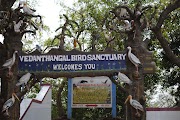Family
In Search of that Perfect Picture...
Amidst the Architectural Marvels of Thanjavur!
I am a proud owner of a DSLR camera since the last six years. It was a special gift from my husband who doesn't believe in material gifts. "Cameras are for capturing memories", he defended then. I've always used it in the 'Auto' mode. I became a victim of the bored housewife syndrome lately; I was challenging myself to do something out of my comfort zone. The challenge is to learn the 'Manual' mode of my camera.
The three of us along with my father were on our way to Thanjavur to see the marvel of the Cholas, The Big Temple. I had a mission to get a stunning photograph of the temple in the 'Manual' mode of my beloved DSLR—the cloudy sky with perfect blues hues as the backdrop, the rich and antique brown temple filling the foreground—complete with the birds flying above!
I browsed different photography sites, read many forums, and learned all the jargons. After all, there are only two modes: one to control the speed of the lens' shutter to take moving things; and another to control the width of the lens' opening for close-up shots. It seemed simple enough. I was confident that I got it all.
Some of my husband's friends decided to tag along from Pattukottai, a nearby town. It was five in the evening when we reached. The evening looked perfect for my photography plan when someone wanted tea. The shops were at least a kilometer away and the locals suggested us to take an auto to secure our parking spot. The entire ordinance took us a good hour. I had lost the light when we entered the temple.
The UNESCO World Heritage temple looked ethereal in the moonlight, the crescent of the moon and the light on top of the gopuram called for that perfect picture. I did the following set of actions: switch the camera on, turn the knob to M, increase f value to the largest, shutter speed to the lowest, and shoot. The shutter took forever to close. The blurry image was unrecognizable, looking more like a modern art in the LCD screen. After frantically adjusting every knob and button, I gave up, frustrated. The heavily crowded temple was no place to think clearly about ISO, exposure, and other settings. So, I blamed it on the camera, deeming it very basic. Then, I saw someone with a tripod. I was contemplating my next move when my husband warned me with a no-one-borrows-a-tripod look.
In the midst of my photo hunting, I was oblivious to the wonderful little things around me: my son's curiosities, my husband's enthusiasm, my dad's history lessons, and the friends' well-meaning chatters.
I managed to get some photos, but nothing even remotely resembled my imaginative perfect picture. My husband promised to return the next day early in the morning to let me shoot for my heart's content. It was around 10 when our family reached and the morning sun was harsh. My photos were too washed out. Again, my theoretical internet research failed me.
"When you want good shots, look around. Don't dig your nose in the camera", my father advised. "If you don't include us in your shots, then there are no memories to take back", my husband pitched in. I read somewhere that the next best thing to the manual mode is the 'Aperture Priority' mode. So, I turned the knob to 'A' and started shooting.
The gigantic temple remained elusive to my skills. When I let go of the camera setting and looked around, I got some beautiful candid shots of my family: my son feeling the ancient letters etched in stone; grandfather and grandson merrily rolling the lawn; father and son having a deep conversation.


There is a quote I remember from the movie, The Best Exotic Marigold Hotel, "The only failure is the failure to try". Even with all the overexposed, underexposed, and blurry images, I am glad that I tried. My photographs are not winning any awards—nor do they have the perfect exposure—but they are memories that touch my heart!






1 Comments
Well written. All the best.
ReplyDelete